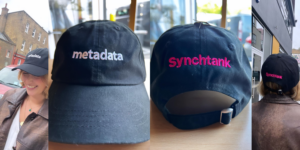Let’s talk about catalogs. Depending on where you work, be that a label, publisher or production music library, your catalog is likely to contain thousands, if not hundreds of thousands (and maybe even millions) of tracks, combining frontline hits with historic gems and multiple variations in between – from instrumentals to 30 second versions and remixes.
So what has that got to do with metadata, AI, and search? Well, everything!
AI – and AI generated music specifically – is undoubtedly the most hotly debated industry topic of the moment. But as the panic surrounding the impending explosion of AI-created tracks intensifies, it’s easy to forget the vast archives of human-created music that already exist. Music that could be put to use and monetized, but instead might be left to simply gather dust.
That’s where AI comes in. Thanks to a growing wave of companies pioneering AI recommendation, tagging and search solutions, music catalogs have never been more discoverable, and therefore their revenue potential has never been greater.
And while fear mounts around AI generated music displacing parts of the sync industry, the reality remains that there are complex legal and copyright issues surrounding this type of music – issues that may take months or even years to resolve. This means the best, safer choice for content producers remains music from trusted industry suppliers.
In this article we break down the meaning and importance of AI-powered search and discovery solutions and how anyone working with music – on the buy or sell side – can harness them to streamline their day-to-day lives.
Metadata

Without accurate metadata, the track becomes impossible to find, be that on streaming platforms or within an internal catalog and – most important of all – the copyright owners cannot be paid when it gets used commercially.
When it comes to descriptive metadata (the focus of this article), consistency is key. But tagging a catalog manually has its limitations – human error gets the best of us all and we tend to be subjective in our descriptions, leading to inconsistency. And then there’s the time factor – imagine how long it would take to tag thousands of tracks individually.
All this can be eliminated and updated in a matter of seconds with AI, which leads us to the next section…
Tagging
One of the primary uses for AI here is its ability to automatically tag large catalogs in seconds, creating huge time savings and efficiencies for anyone working with music.
This AI technology is capable of analyzing catalogs and instantly providing comprehensive, descriptive metadata specifically tailored to meet the search needs of those working in sync and media productions.
Tagging gives you the power to easily explore the depths of your catalog and return more accurate search results to cater to the growing needs of content creators, playlist curators, and music supervisors with unparalleled precision.
And as catalogs continue to grow through new signings and acquisitions, they can be continually optimized through automated AI tagging.
But still, the technology doesn’t stop there…
Sonic Similarity
With sonic similarity or similarity search, you can instantly discover tracks similar to a reference track by simply pasting a link or uploading a file. For instance, if you’re eager to use a Red Hot Chilli Peppers track but lack the budget, you can effortlessly find comparable tracks in your catalog using a system equipped with sonic similarity search.
You can even go further and search particular segments of a song to return similar results, and suppress vocals when searching for more accurate instrumental identification.
The time saving benefits here are obvious – those using systems with this functionality report time savings of up to 90% on searches, enabling faster responses to briefs and more accurate pitches. It’s a win-win situation.
This technology truly has the power to unlock the full revenue potential of any catalog by unearthing hidden gems and even the most obscure remix or song version.
But let’s say you don’t have a reference track in mind and want to search using a specific phrase or description, well there is the technology for that too…
Natural Language Search
As AI technology progresses so do the search interfaces available. Thanks to the likes of ChatGPT we’re becoming increasingly familiar with conversational, prompt-based searches and these can also be applied to music.
While keyword searches in music can be extremely effective, they have their limitations. Natural language search allows users to go one step further and search music catalogs using their own words, whether that’s a particular phrase, sync brief, or even a scene description. For example:
- “Tumbleweed rolling along an empty highway”
- “Snowflakes falling on a frozen lake”
- “Summery, a light pop featuring a groovy acoustic guitar”
Again these capabilities provide huge time savings and the ability to super serve clients and productions with more accurate searches and faster turnarounds.
Who provides this technology?
There are a growing number of companies and technologies that are helping to redefine music search with AI.
At Synchtank we’ve been honing our best-in-class search interfaces for over a decade to provide scalable and configurable solutions to the largest rightsholders and buyers.
We also work with best in-class partners, including AIMS and Cyanite, to seamlessly integrate these cutting-edge AI functionalities into our platform and help our clients make their catalogs more searchable and accessible.
As content volumes continue to explode, these technologies will only become more essential to music and media workflows – and even more crucial in unlocking much needed value for rightholders.
Head here to learn more about Synchtank’s AI search and discovery capabilities

1 comment
In addition to Sonic Similarity and Natural Language Search, Harmix recently launched a search by video and song narrative. The Harmix team also combined all four searches, e.g. you can upload a reference track and refine the search with natural language – worth checking out!